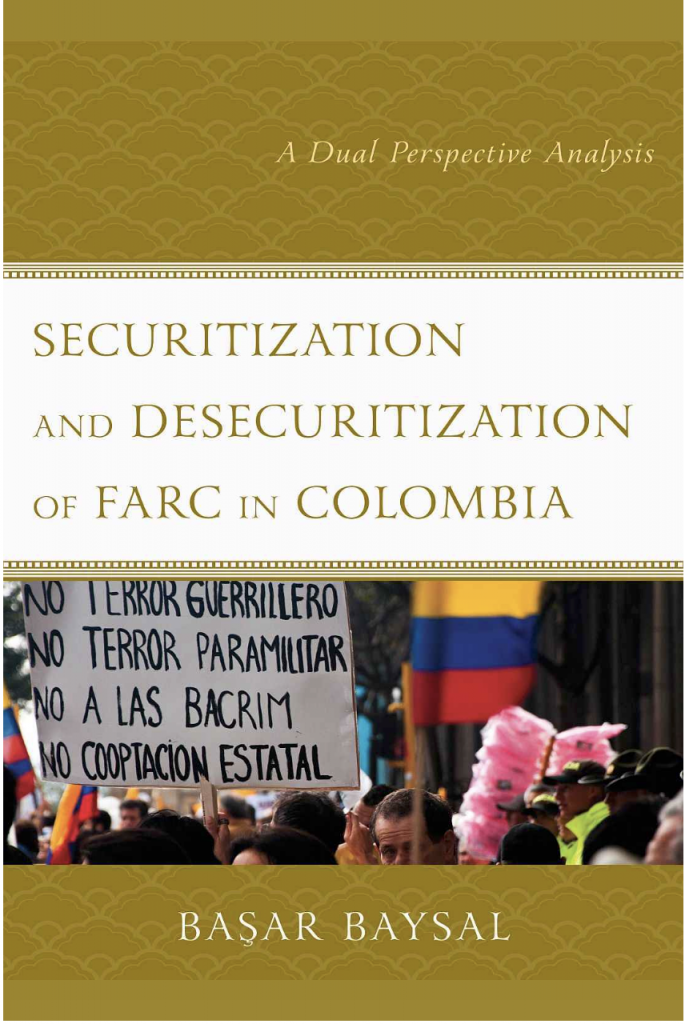
Başar Baysal, 2019. Securitization and Desecuritization of FARC in Colombia, Lexington Books.
The study of illegal armed organizations is difficult. Data availability is limited, as is access to key actors. When conflicts end, therefore, scholars face the opportunity to trace processes, and unpack the black box of how illegal organizations work and evolve, and how they adapt their strategies in interplay with the wider international, political, and social context, and with the strategies of their antagonists (usually state or government forces).
Securitization and Desecuritization of FARC in Colombia, by Başar Baysal offers a rare glimpse at the transformation of an illegal armed organization—the Fuerzas Armadas Revolucionarias de Colombia (FARC) from the point of view of securitization. The book provides a theoretical framework—labeled ‘dual securitization’—of the mutual securitization among the Colombian state and the FARC rebels across time, as defined initially in the FARC’s founding manifesto and the Colombian Armed Forces’ Lasso Plan. This interplay between the conflict’s main actors is one of the main contributions of the book, as it shows to what extent ‘primary and counter-securitizations are active’ and dynamic, especially in contexts of conflicts of long duration.
The book’s main aspiration is of a theoretical nature. It dedicates the bulk of the document to describing existing theories and their limitations. It begins with securitization theory and credits Ole Wæver’s seminal description of security as a ‘speech act’ (Wæver, 1995), which justifies discourse-centered research methodologies. The book complements this approach with a description of International Political Sociology and adds a discussion of the limitations of securitization theory, such as its perceived elitism and its applicability beyond the West. To overcome some of the limitations of Western-centered securitization accounts, it proposes the inclusion of context variables, mainly the quality and level of democracy as well as state capacity as mediating factors in the mutual securitization among actors. In brief, low levels of democracy and state capacity increase the likelihood of securitization. The author also includes the international dimension in the description of contexts shaping securitization.
The book then proposes its ‘dual’ securitization approach, which it describes as a ‘novel framework for critical security studies to examine the process of securitization’ (p. 69). The approach ‘takes both discourses and practices of security into consideration’ (p.69), defines phases of the securitization process (decision, construction, and (in)securitization-in-action) and adds to the analysis securitizing actors and referent objects beyond the state. The main purpose of this dual framework, according to the author, is ‘to present how different views conflict for their truth claim and how these clashes impact the construction of this truth (i.e. security definition)’ (p. 71).
In the final chapters, the book applies the dual securitization framework to Colombia, specifically to the armed conflict between FARC and the Colombian state. The securitization process, as stated by the author, started in the 1960s with the securitization of communists by the Colombian state (in line with Cold War trends and policies), continued with FARC’s manifesto’s emphasis on the state as enemy of the people, and ended in 2016 with a peace agreement between both actors. The agreement has lasted over three years. The author chose the Colombian case because it ‘is a clear example of a dual securitization’, in which it is possible to trace the dynamic and mutually determined process of securitization among the groups and the state. The Colombian peace process has attracted significant international attention: It managed to overcome seeming intractability and produce an agreement to end conflict with one of the Western Hemisphere’s last insurgent groups. Although it has been studied from multiple angles, this approach of mutual (dual) securitization is indeed unprecedented.
At the same time, the book leaves several open questions. On the one hand, the reader may be puzzled as to whether the book’s argument benefited from hindsight or from post-factual analysis: How can we know that desecuritization was effective in bringing FARC to the negotiation table? In addition, to what extent can a successful peace process be considered synonymous for desecuritization? Finally, it would be interesting to see if securitization really ends with a peace agreement—as suggested by the author for the case of Colombia—and to what extent current debates on postconflict security issues, in which FARC and the passions it evokes among Colombian citizens still play a central role, are still marked by the legacy of conflict-related securitization. This applies, for example, to the fight against illicit crops, which have for decades fueled the Colombian conflict, and which continue to influence and weaken Colombian security in the aftermath of armed conflict.
The author developed his framework on the Colombian case without any access to primary sources (for example by conducting field work in Colombia) and in fact relied on limited secondary sources. This is a weakness of the research (acknowledged by the author himself), which would have benefited from stronger empirical, archival, and historical work and from the opportunities to substantiate some of the ‘dual securitization’ framework’s assertions with evidence on the ground. It might even have been interesting to better structure the comparison with Turkey and the PKK, which is mentioned occasionally but not developed in a full-fledged analysis.
Despite these shortcomings, this timely work by Başar Baysal provides a valuable look at a topic that has not been addressed in depth and contributes to the academic literature that blooms when armed conflicts end. The book leaves readers with a valuable framework that should be further analyzed and tested across cases.
References:
Wæver O (1995) Securitization and desecxuritization. In: Lipschutz R (ed) On Security. New York: Columbia University Press, 46-96.
AngAngelika Rettberg is a professor at the Political Science Department at Universidad de los Andes (Bogotá – Colombia) and a Global Fellow at the Peace Research Institute of Oslo (PRIO).